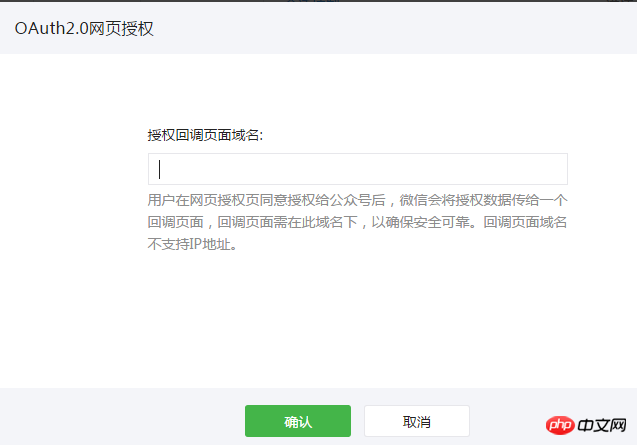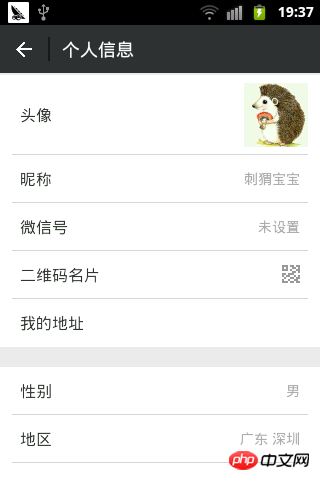 Backend Development
Backend Development
 PHP Tutorial
PHP Tutorial
 How to obtain basic information of users following WeChat public platform with PHP
How to obtain basic information of users following WeChat public platform with PHP
How to obtain basic information of users following WeChat public platform with PHP
This article mainly introduces how PHP obtains the basic information of users following the WeChat public platform. Interested friends can refer to it. I hope it will be helpful to everyone.
Combining WeChat with third-party websites is a solution that many customers often ask for. Here is a brief introduction to obtaining basic information of WeChat users and logging in directly on third-party websites.
When a WeChat public account follows a public account, a unique OpenID will be generated. At this time, we need to use it to request the WeChat server to obtain the user's basic information, including avatar, nickname, etc.
For more detailed instructions, please refer to the WeChat development documentation.
The steps to obtain are as follows:
1 Step 1: The user agrees to authorize and obtain the code
2 Step 2: Exchange the code for web page authorization access_token
3 Step 3: Refresh access_token (if necessary)
4 Step 4: Pull user information (scope is required to be snsapi_userinfo)
5 Attachment: Verify whether the authorization certificate (access_token) is valid
1. On the WeChat public platform - Developer Center: Obtain user basic information through web page authorization: click "Modify" and configure the web page callback domain name

2. User authorization to obtain code
Required resources:
$appid = '**********************';
$appsecret = '***** **********************';
Note: redirect_url is the callback link address for redirection after authorization. Please use urlencode to process the link.
Add the configured $url = 'https://open.weixin.qq.com/connect/oauth2/authorize?appid='.$appid.'&redirect_uri=http:// at the website entrance jixian.c.zmit.cn/&response_type=code&scope=snsapi_userinfo&state=123&connect_redirect=1#wechat_redirect';
and request access to the appeal url.
When the user is authorized, the set domain name will be called back, and the code we need will be spliced into the url parameter. We can directly use $_GET['code'] to get it!
3. Obtain web page authorization access_token and openid through code
$token_url = 'https://api.weixin.qq.com/sns/oauth2/access_token?appid='.$appid .'&secret='.$appsecret.'&code='.$code.'&grant_type=authorization_code';
$token = json_decode(file_get_contents($token_url));
$opendid= $token->openid ;
$access_token = $token->access_token;
4. Obtain user information
$info_url = 'https://api.weixin.qq.com/sns/userinfo ?access_token='.$access_token.'&openid='.$opendid.'⟨=zh_CN';
$info = json_decode(file_get_contents($info_url));
$data['name'] = $info ->nickname;
$data['image'] = $info->headimgurl;
print_r($info);
5. After obtaining the user's openid and other information, We can store it in the database. As long as there is an openid, it is equivalent to the WeChat user having logged in to the website!
Use the access_token obtained by AppID and AppSecret to obtain the user's basic information through the global Access Token
1. When the user follows or replies to a message, the user's OpenID can be obtained
<xml> <ToUserName><![CDATA[gh_b629c48b653e]]></ToUserName> <FromUserName><![CDATA[ollB4jv7LA3tydjviJp5V9qTU_kA]]></FromUserName> <CreateTime>1372307736</CreateTime> <MsgType><![CDATA[event]]></MsgType> <Event><![CDATA[subscribe]]></Event> <EventKey><![CDATA[]]></EventKey> </xml>
The FromUserName is OpenID
2. Then use the access_token interface to request the global Access Token
https://api.weixin.qq.com/cgi- bin/token?grant_type=client_credential&appid=APPID&secret=APPSECRET
Return result:
{
"access_token": "NU7Kr6v9L9TQaqm5NE3OTPctTZx797Wxw4Snd2WL2HHBqLCiXlDVOw2l-Se0I-WmOLLniAYLAwzhbYhXNjbLc_KAA092cxkmpj5FpuqNO0IL7bB0Exz5s5qC9Umypy-rz2y441W9qgfnmNtIZWSjSQ",
"expires_in": 7200
}3. Then use global ACCESS_TOKEN to obtain OpenID details
https://api.weixin.qq .com/cgi-bin/user/info?access_token=ACCESS_TOKEN&openid=OPENID
Return as follows:
{
"subscribe": 1,
"openid": "oLVPpjqs2BhvzwPj5A-vTYAX4GLc" ,
"nickname": "Hedgehog Baby",
"sex": 1,
"language": "zh_CN",
"city": "Shenzhen",
"province" : "Guangdong",
"country": "China",
"headimgurl": "http://wx.qlogo.cn/mmopen/JcDicrZBlREhnNXZRudod9PmibRkIs5K2f1tUQ7lFjC63pYHaXGxNDgMzjGDEuvzYZbFOqtUXaxSdoZG6iane5ko9H30krI bzGv/0",
"subscribe_time": 1386160805
}
At this point, the user’s basic information is obtained.
This method is most suitable for users to reply with a message welcoming the user's nickname when following it, as shown in the reply when following the public account below. Scan the QR code to experience it.



Summary: The above is the entire content of this article, I hope it will be helpful to everyone's study.
Related recommendations:
TP5 method of uploading files in PHP
TP5 Request request object in PHP Method
php method to implement monomorphic design pattern
The above is the detailed content of How to obtain basic information of users following WeChat public platform with PHP. For more information, please follow other related articles on the PHP Chinese website!

Hot AI Tools

Undresser.AI Undress
AI-powered app for creating realistic nude photos

AI Clothes Remover
Online AI tool for removing clothes from photos.

Undress AI Tool
Undress images for free

Clothoff.io
AI clothes remover

Video Face Swap
Swap faces in any video effortlessly with our completely free AI face swap tool!

Hot Article

Hot Tools

Notepad++7.3.1
Easy-to-use and free code editor

SublimeText3 Chinese version
Chinese version, very easy to use

Zend Studio 13.0.1
Powerful PHP integrated development environment

Dreamweaver CS6
Visual web development tools

SublimeText3 Mac version
God-level code editing software (SublimeText3)

Hot Topics
 1392
1392
 52
52
 Alipay PHP SDK transfer error: How to solve the problem of 'Cannot declare class SignData'?
Apr 01, 2025 am 07:21 AM
Alipay PHP SDK transfer error: How to solve the problem of 'Cannot declare class SignData'?
Apr 01, 2025 am 07:21 AM
Alipay PHP...
 Explain JSON Web Tokens (JWT) and their use case in PHP APIs.
Apr 05, 2025 am 12:04 AM
Explain JSON Web Tokens (JWT) and their use case in PHP APIs.
Apr 05, 2025 am 12:04 AM
JWT is an open standard based on JSON, used to securely transmit information between parties, mainly for identity authentication and information exchange. 1. JWT consists of three parts: Header, Payload and Signature. 2. The working principle of JWT includes three steps: generating JWT, verifying JWT and parsing Payload. 3. When using JWT for authentication in PHP, JWT can be generated and verified, and user role and permission information can be included in advanced usage. 4. Common errors include signature verification failure, token expiration, and payload oversized. Debugging skills include using debugging tools and logging. 5. Performance optimization and best practices include using appropriate signature algorithms, setting validity periods reasonably,
 How does session hijacking work and how can you mitigate it in PHP?
Apr 06, 2025 am 12:02 AM
How does session hijacking work and how can you mitigate it in PHP?
Apr 06, 2025 am 12:02 AM
Session hijacking can be achieved through the following steps: 1. Obtain the session ID, 2. Use the session ID, 3. Keep the session active. The methods to prevent session hijacking in PHP include: 1. Use the session_regenerate_id() function to regenerate the session ID, 2. Store session data through the database, 3. Ensure that all session data is transmitted through HTTPS.
 Describe the SOLID principles and how they apply to PHP development.
Apr 03, 2025 am 12:04 AM
Describe the SOLID principles and how they apply to PHP development.
Apr 03, 2025 am 12:04 AM
The application of SOLID principle in PHP development includes: 1. Single responsibility principle (SRP): Each class is responsible for only one function. 2. Open and close principle (OCP): Changes are achieved through extension rather than modification. 3. Lisch's Substitution Principle (LSP): Subclasses can replace base classes without affecting program accuracy. 4. Interface isolation principle (ISP): Use fine-grained interfaces to avoid dependencies and unused methods. 5. Dependency inversion principle (DIP): High and low-level modules rely on abstraction and are implemented through dependency injection.
 How to debug CLI mode in PHPStorm?
Apr 01, 2025 pm 02:57 PM
How to debug CLI mode in PHPStorm?
Apr 01, 2025 pm 02:57 PM
How to debug CLI mode in PHPStorm? When developing with PHPStorm, sometimes we need to debug PHP in command line interface (CLI) mode...
 How to automatically set permissions of unixsocket after system restart?
Mar 31, 2025 pm 11:54 PM
How to automatically set permissions of unixsocket after system restart?
Mar 31, 2025 pm 11:54 PM
How to automatically set the permissions of unixsocket after the system restarts. Every time the system restarts, we need to execute the following command to modify the permissions of unixsocket: sudo...
 Explain late static binding in PHP (static::).
Apr 03, 2025 am 12:04 AM
Explain late static binding in PHP (static::).
Apr 03, 2025 am 12:04 AM
Static binding (static::) implements late static binding (LSB) in PHP, allowing calling classes to be referenced in static contexts rather than defining classes. 1) The parsing process is performed at runtime, 2) Look up the call class in the inheritance relationship, 3) It may bring performance overhead.
 Framework Security Features: Protecting against vulnerabilities.
Mar 28, 2025 pm 05:11 PM
Framework Security Features: Protecting against vulnerabilities.
Mar 28, 2025 pm 05:11 PM
Article discusses essential security features in frameworks to protect against vulnerabilities, including input validation, authentication, and regular updates.



